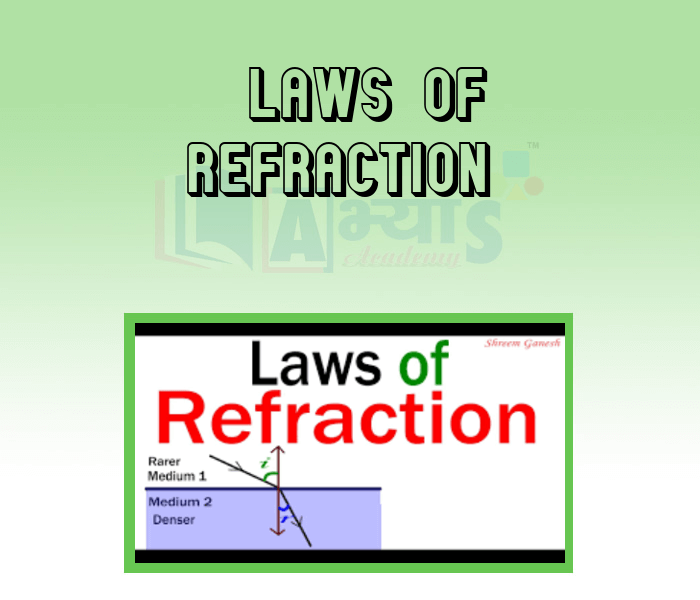Laws of Refraction










Laws of Refraction
The way a ray of light refracts when it is incident on the surface separating two media depends not only on the refractive indices of the media but also on the angle of incidence.
In the given figure there are two mediums : Air and Water. Let their refractive indices be and
respectively. The two media can be any pair such as air and water, or air and glass. Suppose a ray of light called as incident ray traveling in medium air, is incident on the surface of water body . Draw a normal to the surface at the point of incidence of incident ray.
The formed between the incident ray and the normal is called the angle of incidence
.
The between the refracted ray and the normal is called the angle of refraction
.
The ray of light inside the medium is called as refracted ray.

Laws Of Refraction:
Two laws of refraction governs the refraction that takes place at a surface of separation.
1. The incident ray, the normal and the refracted ray to the refracting surface at the point of incidence lie in the same plane.
2. The angle of incidence and the angle of refraction satisfy the equation
The second law given above is also called Snells law.
If refracted angle is grater then incidence angle, which of the following statements is true ? | |||
| Right Option : B | |||
| View Explanation |
Which of the following are correct ? (a) The way a ray of light refracts when it is incident on the surface separating two media depends not only on the refractive indices of the two media but also on the angle of incidence. (b) The angle formed between the incident ray and the normal is called the angle of refraction. (c) The ray of light coming from medium 1 when it is inside the medium it 2 is called as refracted ray . | |||
| Right Option : C | |||
| View Explanation | |||
The angle between the refracted ray and the normal is called the ____________________ .
| |||
| Right Option : A | |||
| View Explanation | |||
Students / Parents Reviews [10]
My experience with Abhyas is very good. I have learnt many things here like vedic maths and reasoning also. Teachers here first take our doubts and then there are assignments to verify our weak points.

Shivam Rana
7thIt was good as the experience because as we had come here we had been improved in a such envirnment created here.Extra is taught which is beneficial for future.

Eshan Arora
8thMy experience with Abhyas academy is very good. I did not think that my every subject coming here will be so strong. The main thing is that the online tests had made me learn here more things.

Hiya Gupta
8thOne of the best institutes to develope a child interest in studies.Provides SST and English knowledge also unlike other institutes. Teachers are co operative and friendly online tests andPPT develope practical knowledge also.

Aman Kumar Shrivastava
10thIt was a good experience with Abhyas Academy. I even faced problems in starting but slowly and steadily overcomed. Especially reasoning classes helped me a lot.

Cheshta
10thMy experience was very good with Abhyas academy. I am studying here from 6th class and I am satisfied by its results in my life. I improved a lot here ahead of school syllabus.

Ayan Ghosh
8thAbhyas is a complete education Institute. Here extreme care is taken by teacher with the help of regular exam. Extra classes also conducted by the institute, if the student is weak.

Om Umang
10thAbhyas Methodology is very good. It is based on according to student and each child manages accordingly to its properly. Methodology has improved the abilities of students to shine them in future.

Manish Kumar
10thAbout Abhyas metholodology the teachers are very nice and hardworking toward students.The Centre Head Mrs Anu Sethi is also a brilliant teacher.Abhyas has taught me how to overcome problems and has always taken my doubts and suppoeted me.

Shreya Shrivastava
8thBeing a parent, I saw my daughter improvement in her studies by seeing a good result in all day to day compititive exam TMO, NSO, IEO etc and as well as studies. I have got a fruitful result from my daughter.
